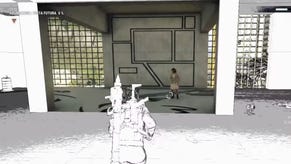Just Cause 4 performance analysis: every console tested
The game's massively more ambitious than JC3 - but do frame-rates hold up?
Can Avalanche get the Just Cause franchise back on course? The arrival of the latest series entry this week sees the developer scaling up its ambitions for the game: even more insane physics, more diverse tasks, more action-packed missions and the arrival of adverse weather conditions spread across four different biomes. Bearing in mind how much the last game struggled on consoles, has the developer bitten off more than it can chew? It's against the odds perhaps but the truth is that Just Cause 4 pulls it off - the game is far more challenging on console hardware and yet the performance delivered is a night and day improvement over its predecessor.
What we like about the series remains in effect here - the open world is vast and Rico Rodriguez can explore it as he sees fit, meting out his own particular brand of explosive justice - but far more of an effort is made to push the game's systems to even more spectacular effect. Boosters, airlifters and retractors add more utility to the grapple system and not only up the ante in terms of destruction, but also open the door to some basic puzzling. New weapons show some Insomniac-level imagination, and this time iron sights are open right from the beginning, adding some much-needed precision to the blasting. Vehicle handling? That's been a focus for Avalanche too, with much improvement over the last game.
The arrival of adverse weather conditions is a highlight too - twisters can rip through towns, cities and bases, smashing through bridges, ripping all destructible scenery and vehicles from the ground, while high-speed winds during a sandstorm up-end gameplay and enhance the destruction still further. And depending on the console you play, everything runs without a hitch - for the most part. Yes, Square-Enix did promise an emphasis on smooth performance during development, but bearing in mind just how much of a battering frame-rate could take on Just Cause 3, and just how many times gamers have been let down by poor CPU performance from the current-gen Jaguars, it's easy to be pessimistic about the sequel's chances here, especially with the physics system pushed so hard.
So how has Avalanche pulled this off? There's no such thing as a free lunch in real-time rendering but at the same time, there's a lot of optimisation work in effect here. For a start, most of the game has been re-coded from the ground up for enhanced performance - with a particular focus on moving the Havok physics system to soak all available CPU cores. Secondly, Avalanche has done a lot of work on the graphics side, reducing the impact that large explosions have on GPU power while at the same time introducing dynamic resolution scaling on all systems, and it's here where a trade is made - one that's particularly noticeable on the base machines.
Of course, this is the first Just Cause title to arrive within the lifespan of the enhanced consoles too, both of which feature significant CPU frequency upgrades over their vanilla equivalents - along with much more GPU power. In terms of core spec, Xbox One X takes point here, delivering a top-end 3840x2160 but more often settling in 1440p territory when the game engine is under significant load. Square-Enix tells us that the scaler here can drop as low as 1080p but if this does happen, it's very rare - it's by far the cleanest presentation out of all of the console releases. PlayStation 4 Pro scales between 1080p and 1440p, but we found that the lower end of the scale is more common in action scenes.
Square-Enix also says that we're looking at a maximum 1080p and 900p on PS4 and Xbox One respectively but both of these machines can hit a 720p minimum - and it happens frequently enough to give both a very grainy presentation for much of the duration. PS4 has a resolution edge - as the comparison shots on this page demonstrate - but it's a clear step-down in clarity for both machines compared to JC3. Resolution is the price to pay for smoother Just Cause performance then and the key trade Avalanche has made, but it's surprising that out of our pixel-count samples, only Xbox One X actually delivers a wide range of different resolutions from the DRS system.
I'd say that the price to pixel-count is worth paying overall as the performance boost over JC3 is profound. The smoothest version of the bunch is PlayStation 4 Pro, which barely budges from the 30fps target, no matter how intense the on-screen action. This is closely followed by Xbox One X; yes, it has a big visual advantage over the Pro and while it is mostly locked at 30fps, occasional dropped frames do crop up - mostly invisible during the course of the action. The base PlayStation 4 game follows next. As you would expect for a machine with the highest installed base, this one is effectively the lead platform and in performance terms, it mostly holds up as well as the enhanced machines, with only occasional slow-down.
























This leaves the standard Xbox One, once again set apart at the bottom of the pile. The base Microsoft machine still delivers a big, big improvement over Just Cause 3's frame-rates however, but do expect to see frequent performance dips. You may expect the drop in resolution to be more than enough to equalise performance with the PlayStation 4 version of the game, but handling high bandwidth effects in a performant manner practically demands the use of the ESRAM, which is in vanishingly short supply for the demands of the latest games.
The plan at Avalanche is to revisit how ESRAM is utilised in a future patch with a view to delivering improved performance, but it does seem like the embedded memory is the likeliest reason why the vanilla Xbox One is starting to struggle - and not just in this game, but a bunch of recent releases too. With the arrival of the enhanced X console, three out of the four console targets now feature unified, high bandwidth GDDR5 memory - a more convenient set-up for developers to work with.
Based on what we've seen from the game across all consoles so far, performance is clearly a major step up, and I hope that Avalanche continues to make improvements. A little more polish would also be welcome - the texture streaming system can occasionally stall, leaving low resolution art on-screen, while I've found Rico to be trapped within tight spots in environments on a couple of occasions, until I'm blown back to freedom via enemy fire. The menu system is also slow and somewhat laggy to respond, while geometry and shadow pop-in at altitude can be a touch distracting. But some of the other weirdness and oddities I've witnessed during play are just par for the course for a Just Cause game - and some of the physics-based mishaps can be hilarious.
Overall though, what I've played of Just Cause 4 so far suggests a game that delivers on its promises of more ambition, more variety and more physics-driven destruction, without the compromises to performance that marred its predecessor. The icing on the cake? Loading times are vastly improved too compared with swift 10-15 second transitions between levels - and no lengthy waits if you fail a mission. It's another example of how Avalanche has responded to feedback on the last game and come back with a faster, smoother sequel. That said, Just Cause 4 isn't perfect technically: the dynamic scaler does seem too aggressive on PS4 and Pro, while base Xbox One performance could use some work. The fun factor is here in spades though - and this time, the game engine doesn't get in the way of the thrills.










